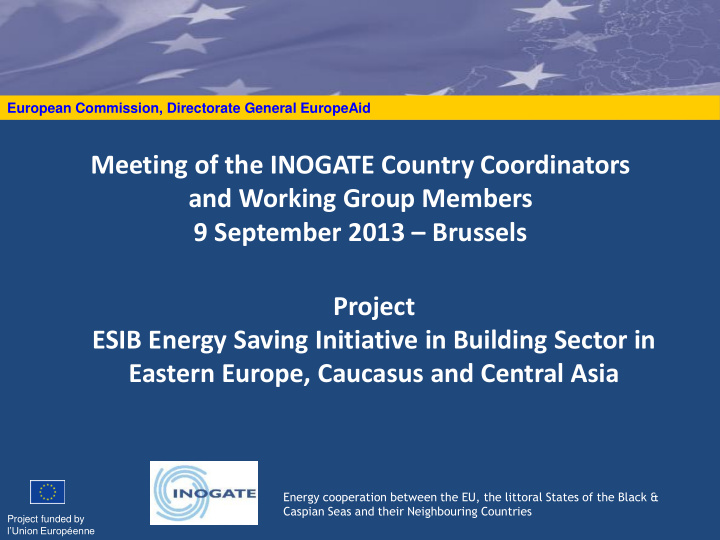



European Commission, Directorate General EuropeAid Meeting of the INOGATE Country Coordinators and Working Group Members 9 September 2013 – Brussels Project ESIB Energy Saving Initiative in Building Sector in Eastern Europe, Caucasus and Central Asia Energy cooperation between the EU, the littoral States of the Black & Caspian Seas and their Neighbouring Countries Project funded by l’Union Européenne
How to achieve EE in buildings? Why ESIB? Contribute to releasing the energy saving potential due to low energy raising efficiency in buildings awareness among promoting people demonstrating with financing examples technical mechanisms and economic improving feasibility of energy legislation, efficiency in norms and construction and standards maintenance of and buildings
ESIB Activities and Events Task 1 Awareness • ESIB Webpage www.inogate-ee.org, +900 visitors/month • 16 Webinars on energy efficiency topics, +40 attendants/ webinar +640 participants • Training of students in schools and universities • Competitions for students and for journalists about energy efficiency best ideas and articles • Dissemination of Newsletters, booklets and leaflets • Elaboration of an “Awareness Toolbox” for the use of governments agencies and departments • Training of journalists on EE issues (Astana, Baku, Tbilisi, Chisinau, Kiev, Bishkek, …. +100 trainees)
ESIB Activities and Events Task 2 Legislative • Analysis of the legislation related to Energy Efficiency in Buildings, standards and norms • Gap analysis with EBPDs in the INOGATE countries • Analysis of the legislation that regulates setting up of Home Owners Associations identify the main barriers to energy efficiency rehabilitation • Labeling of Electric Appliances - Acting legilsation in participating countries was analysed and recommendations issued - Setting up of condominiums in three countryes: KG, UA and AZ. Elaborattion of a handbook for homeowners in residential buildings
ESIB Activities and Events Task 2 Legislative • Main outputs and recommendations indicate how to make EE laws better linked to the acting norms and standards in each country • How to implement and manage energy audits of buildings • How to issue and use buildings energy certificates • How to set up home owners associations in response to the dismantlement of communal service companies The results will be presented in events grouping countries: - November 2013 Ukraine Kommuntek - December 2013 Kyrgyzstan
ESIB Activities and Events Task 3 Banking & Financing • Assessment of the Investment Climate in the Participating Countries • Issuance of a Handbook for Bankers on financing energy efficiency in the building sector • Elaborated the financial plans for EE rehabilitation of buildings based on the results of energy audits Top management of +15 commercial banks was approached and introduced the concept of new products like eco-credit now in the pipeline of the cooperation 1. Training of bankers (KZ and BY , 30 bankers) 2. Presentation of the Handbook 3. Financing a pilot project
ESIB Activities and Events Task 3 Banking & Financing Main building categories for financing: - Public - Private, residential buildings. Individual owners and HOAs - Public buildings Hotels in Crimea Ukraine - Bank EE rehabilitation financing products are not sufficiently developed - Interest rates to high to be affordable by home-owners - Lack of trust towards the banks, high risk for collaterals - Unhomogeneous way of calculating payback period - Subsidesed energy tariffs against high cost of construction materials
ESIB Activities and Events Task 3 Banking & Financing Pilot projects: public, residential and commercial. More than 22 • In some countries public buildings benefit of state support • Residential buildings lack financial instruments for rehabilitation • Commercial buildings are the most suitable • Accountability towards banks • Shorter payback time • Immediate positive impact on business performance
ESIB Activities and Events Task 4 Capacity Building • Assessment of the capacity of the partners organisations • Training of technical staff on energy audit techniques. Real building are used for the training – 270 trained technicians in 10 countries, 22 buildings. • Elaborated a catalogue of building design proposed solutions for the implementation of a standard set of EE measures in the selected buildings • 8 buildings will go thru physical EE rehabilitation
ESIB www.inogate-ee.org
Recommend
More recommend